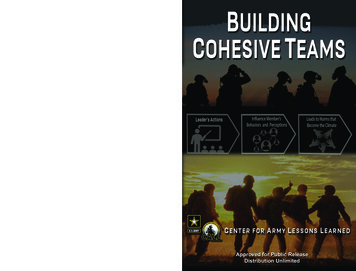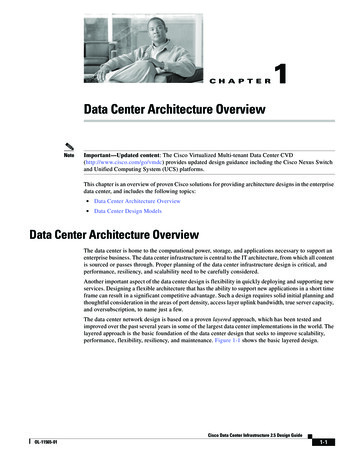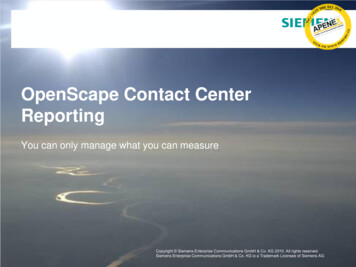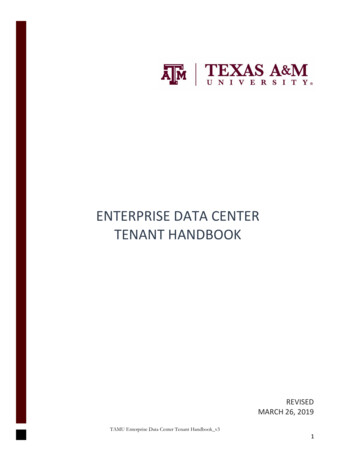
Transcription
No. 21-14CENTER FOR ARMY LESSONS LEARNED10 Meade Avenue, Building 50Fort Leavenworth, KS 66027BUILDING COHESIVE TEAMSlCOMBINED ARMSCENTER - TRAININGApproved for Public ReleaseDistribution Unlimited2021No. 21-142021U.S. ARMYCOMBINEDARMS CENTERApproved for Public ReleaseDistribution Unlimited
CENTER forARMY LESSONS LEARNEDThe Center for Army Lessons Learned leadsthe Army Lessons Learned Program anddelivers timely and relevant information toresolve gaps, enhance readiness, and informmodernization.DIRECTOR. COL Christopher KellerCALL ANALYST. Mr. Ron PruytPUBLISHING DIVISION CHIEF. Mr. Eric HillnerPUBLISHING AND DIGITAL MEDIA CHIEF EDITOR. Mrs. Diana KeelerEDITOR. Ms. Emily Swedlund10 MEADE AVE ILLUSTRATORBLDG 50 . Mrs. Julie GunterFORT LEAVENWORTHKANSAS 66027 SECURITY. Ms. Sandra Griffin@CENTER for ARMYLESSONS LEARNEDREQUEST FOR INFORMATION@USARMY ail.mil
T E A M B U I L D I N G AT TH E SQU A D LEVELForeword“You have to take care of Soldiers and you can’t do it by lip servicebecause they will find you out. It has to come from the heart. If it isn’tgenuine, they’ll know it in a minute.”William G. Bainbridge, 5th Sergeant Major of the ArmyAs we continue to deploy our Soldiers to disparate geographic locationsaround the world, it is important to revisit how to build cohesive teams thatare highly trained, disciplined, and fit. First and foremost, there are no softskills, there is just good leadership. Basic attributes like communication,interpersonal skills, empathy, and compassion are traits that fall under theumbrella of leadership at large. Parallel to society, Army culture also evolves.With this continuous evolution, Army leaders must remain agile and adapt tothe needs of those they lead. Army leaders must exhibit genuine care for theirSoldiers and ask the tough questions. We must remember that caring alsomeans holding Soldiers accountable for their actions. When expectations areset, it is imperative that leaders follow through to ensure they are met.Leading Soldiers is an honor and a privilege. However, this endeavor issometimes difficult and does not come naturally for everyone. That isprecisely why publications like this are so important. We ask our leadersto continually seek self-improvement, and this handbook is a great place tostart. It will not provide you with all the answers, but it can serve as a roadmap to get you where you want to go.People First!Michael A. Grinston16th Sergeant Major of the Armyiii
T E A M B U I L D I N G AT TH E SQU A D LEVELTABLE OF CONTENTSIntroductionAbout this Handbook 9Chapter 1This is My Squad: Overview 11Section I: TeamsChapter 2Building the Team 17Chapter 3Resolving Conflict 27Chapter 4Establishing a Positive Climate 39Section II: IndividualsChapter 5Individual Characteristics 55Chapter 6Stressors and Behavior 59Chapter 7Compliance versus Commitment 65Appendix IClimate Assessment 69Glossary 75References 77v
CENT ER F OR ARMY L E S S O N S L E A R N E DFIGURESFigure 1-1. This is My Squad Overview. Adapted from SMA Grinston’s brief at the 2020Maneuver Conference. 13Figure 4-2. Factors that Contribute to Climate 44Figure 5-1. The Big 5 Continuum 57Figure 6-1. Organizational Stress 60Figure 7-1. Hierarchy of Commitment 66vi
T E A M B U I L D I N G AT TH E SQU A D LEVELTABLESTable 2-1. Team Leader and Team Member Roles and Responsibilities 24Table 3-1. Prioritizes, Organizes, and Coordinates Taskings 28Table 3-2. Process Conflict Indicators and Causes 29Table 3-3. Personal Conflict Indicators and Causes 31Table 3-4. Values Conflict Indicators and Causes 32Table 3-5. Information Conflict Indicators and Causes 33Table 3-6. Structural Conflict Indicators and Causes 35Figure 4-1. Climate versus Culture 40Table 4-1. Impact of Negative and Positive Climates on Organizations 41Table 6-1. Effects of Stress on the Mind, Mood, and Body 61Table 6-2. Adaptive Stress Reactions 61vii
T E A M B U I L D I N G AT TH E SQU A D LEVELINTRODUCTIONAbout this HandbookWHAT IS IN ITThis handbook contains information for leaders on how to build teams andcontribute individually to team success, including how to create a cohesiveclimate and resolve conflict. There are vignettes throughout the handbookto help illustrate key points. These vignettes are experiences from Soldiersacross the Army. Some are from the Sergeant Major of the Army’s (SMA)“This is My Squad” panel, while others were gathered from interviews withleaders and squad members at various locations.WHAT IS NOT IN ITThere is no discussion of leadership styles in this handbook. Current Armydoctrine no longer discusses leadership styles because they are too ‘squishy’and without boundaries, and therefore there is plenty of overlap between thedifferent styles of leadership. Styles are also dependent on team dynamics,such as cohort, rank, or position. Leaders must be flexible and adapt theirstyle to the situation.There may be areas in this handbook that seem like they need furtherdiscussion. Throughout this handbook there are references listed where aleader can go to learn more about a particular topic if interested.The Center for Army Lessons Learned (CALL) published a teambuildinghandbook, the Leader’s Guide to Teambuilding: Building Adaptive HighPerforming Teams, 15 January 2015. This handbook is not intended toreplace the previous version. The Leader’s Guide to Teambuilding was aboutbuilding “teams of leaders” in teams that did not have a habitual relationshipbetween the members, whereas this handbook incorporates the “This is MySquad” initiative.HOW TO USE THIS HANDBOOKThere are two sections in this handbook. The first section is for the leader ofthe team/squad, and discusses climate, conflict, and building the team.The second section covers individual characteristics, including values andemotions, stressors, and commitment and compliance.The reader should read both sections. We are all members of a squad and arelikely the leader of a different squad. This handbook helps both followersand leaders create the highly trained and ready squads that the Army needs tofight and win the nation’s wars.9
T E A M B U I L D I N G AT TH E SQU A D LEVELCHAPTER 1This is My Squad: Overview“This is a cultural change that I want to be positive. Who is in yoursquad? It’s not necessarily an infantry squad, but everyone has a teamof people we’re close with and take care of every day.” SMA Michael A. Grinston16th Sergeant Major of the ArmyThis is My Squad Live PanelJoint Base Lewis-McChordLeaders at all levels should take pride and ownership in their squad andeliminate the behavior that is corrosive to building cohesive squads. In thissense, a squad refers to more than the rifle or engineer squad. It is the groupof people you work with daily, the group for which you are responsible, andthey are responsible to you. This concept is what led to the development ofthe “This is My Squad” initiative, led by the Sergeant Major of the Army(SMA), Michael A. Grinston.Corrosive behavior can be best described as the behaviors that run contraryto Army values, like sexual harassment or assault, racism, suicide, alcoholincidents, and domestic violence. These behaviors are not present in cohesivesquads and teams. A cohesive squad or team will not display these corrosivebehaviors.Every person on the Army team, including Soldiers, Army civilianprofessionals, contractors, and each of their family members are all part ofa squad. Some of the squads you may lead, in others you may be a follower.Think of all the people you interact with on a daily or routine basis. Chancesare that you are part of their squad as well. In this handbook, the terms team,squad, group, and organization are synonymous and used interchangeably.In 1779, Friedrich Von Steuben published Regulations for the Order andDiscipline of the Troops of the United States, or the “Blue Book,” as it wascalled for the color of the paper on which it was printed. This book describedhow to train Soldiers, and what to train them on to prepare them for war.It is also considered the first leadership publication in the Army. It was sosuccessful that it stayed in print until 1812. Thoughts on Army leadershipcontinued to evolve and were codified in 1946 with the publication of FieldManual (FM) 22-5, Leadership Courtesy and Drill, 1 January 1946, and later11
CENT ER F OR ARMY L E S S O N S L E A R N E Din 1948 with the publication of Training Circular (TC) 6, Leadership, 10 July1948, and Department of the Army (DA) Pamphlet (PAM) 22-1, Leadership,December 1948. Though Army leadership theories have evolved, they havealso remained consistent in the sense that they have always been Soldierfocused. Another constant is the knowledge that to build high performingteams that can deploy, fight, and win in any environment, we have to havehighly trained, disciplined, physically fit, and cohesive organizations. Thisis not possible without mutual trust. Mutual trust is not possible withoutunderstanding. Understanding is not possible without knowing one another.The squad leader is the most influential member of the squad. To each squadmember, the squad leader is the leader with whom they are the closest and theperson they can most trust.The squad leader needs to take ownership of their squad. They must knowtheir Soldiers, Army civilian professionals, and other team members wellenough to know what motivates them, know their values and goals, as wellas their strengths and weaknesses. They must know when there is a potentialissue, be it personal or professional, before the issue becomes significantenough to affect team performance.There are four tenets that squads need to exhibit (depicted in Figure 1-1 in thedark green boxes). Squads must be: Cohesive, Trained, Disciplined, and Fit.Army doctrinal publications (ADPs), FMs, and Army techniques publications(ATPs), as well as handbooks from organizations such as the Center for theArmy Profession and Leadership (CAPL), cover the last three tenets. Thishandbook will attempt to expound upon CAPL’s work, referencing much ofit, and cover in detail the first tenet, building cohesive squads.Building a cohesive team is not a soft skill. It is good leadership, andaccomplished through feel, and being aware of team dynamics. However,there are principles and guidelines to follow. Instilling discipline, rewardingdesired behavior, and punishing behaviors detrimental to cohesiveness areall of part of building a high performing team. Figure 1-1 depicts the SMA’s“This is My Squad” initiative, and what the squad leader must do.12
T E A M B U I L D I N G AT TH E SQU A D LEVELFigure 1-1. This is My Squad Overview. Adapted from SMAGrinston’s brief at the 2020 Maneuver Conference.13
SECTION ITEAMS
T E A M B U I L D I N G AT TH E SQU A D LEVELCHAPTER 2Building the TeamA team is any collection of people that functions together to perform amission or collective task. Army Doctrine Publication (ADP) 6-22Army Leadership and the Profession31 July 2019CATEGORIES OF TEAMSThe Army is a team of teams (squad of squads). These teams may be permanentor temporary, internal or external. For the purposes of this handbook, thinkof permanent teams as those assigned to the unit that you work with everyday. This may be your traditional squad, or it may be the platoon leader,platoon sergeant, and the squad leaders. A temporary team is a group that isselected for a specific mission, and after said mission, the team is disbanded.Examples include a team that is put together to write a standard operatingprocedure (SOP), or plan an event for an organization.Internal Teams“Internal teams are comprised of leaders, Soldiers, and Army careerprofessionals who are assigned to a specific unit or organization.”1 Theydo not contain anyone from outside of the organization. Internal teams arethe most common. Internal teams have leaders who have formal leadershipauthority.External TeamsExternal teams have, “ members from different organizations, cultures,or agencies, or have backgrounds or bring specific knowledge, skills, andattitudes to the team.”2 When building an external team, leaders may have theability to select members of the team, or at least the organizations that willprovide personnel to the team. External teams are usually designed to solvecomplex issues.17
CENT ER F OR ARMY L E S S O N S L E A R N E DHigh-Performing TeamsTrust is the glue that holds organizations together, lubricates friction,and permits empowerment. Lieutenant General (LTG) (R) Walter F. Ulmer Jr“Fifty Years of Thoughts on Leadership”Calvary and Armor Journal, January-March 2019Building high-performing teams takes hard work, patience, and theinterpersonal skills of the leader.3 Most leaders do not have the benefit ofselecting their own team members, they get what they are given and have todetermine how to make it work. So how does one build a team that performsat a high standard and can incorporate new members on a recurring basis?Teams that perform at a high level share certain characteristics. Thesecharacteristics are listed below, and expounded upon in ADP 6-22: Team members trust each other and are able to predict what eachmember will do. Members work together to accomplish the mission. The team executes their tasks thoroughly and quickly. The team meets and exceeds standards. The team adapts to demanding challenges. The team learns from their experiences and develops pride in theiraccomplishments.TEAM DEVELOPMENTAL STAGESADP 6-22 states that teams experience three developmental stages: Formation, Enrichment, and Sustainment.We will discuss each stage and how leaders can guide their team througheach stage.18
T E A M B U I L D I N G AT TH E SQU A D LEVELFormationLeaders must be able to evaluate and assess the skills of newly assignedpersonnel and quickly integrate them into the team where they can bring themost value and be successful. The formation stage has two steps: receptionand orientation.As stated earlier, leaders do not normally have the ability to select membersfor their team based on skill set or personality. Later in this chapter, we willdiscuss how to build teams when the leader does have the ability to selectteam members.Reception. Ideally, reception starts right after a Soldier is added to the gainsroster and assigned to a position. The leader selects a member of the team asa sponsor and contacts the new Soldier to welcome them to the team. Whenselecting a sponsor, the leader should select someone who is fully committedto the team and exemplifies the organization’s values. The sponsor shouldbe required to complete either the sponsorship training requirements in theArmy Learning Management System (ALMS) or the Electronic SponsorshipApplication Training (eSAT). “Ensure like-gender, marital status, grade, andleadership positions are taken into consideration when assigning sponsors tothe fullest extent possible.”4With new collaboration tools available on government systems, considerusing video chat tools to meet with incoming Soldiers. This will expedite theirintegration to the team, and shorten the orientation process. See Appendix Cof Army Regulation (AR) 600-8-8, The Total Army Sponsorship Program, 28June 2019, for a sponsorship checklist.Orientation. Orientation begins when the newly assigned Soldier arrivesat the new duty station and meets the other team members, learns the layoutand schedule of the workplace, and generally understands conditions.5 If theSoldier has dependents, include them as much as possible when meeting theteam. Remember, the Army reenlists Soldiers, but retains families.Leaders should assess the incoming Soldier to determine their skills andbest fit within the team. Candid discussions are the most effective way toaccomplish this critical step. Soldier expectations and goals must also be apart of this discussion and will help determine specific assignments and rolesfor the Soldier, as well as the norms for the team.Though not required, having lunch or dinner, or other social outing such as ahail and farewell with the Soldier and their family, helps integrate them intothe team faster and on a richer level. Orienting them to the area, both on andoff the installation, helps them acclimate faster to their new assignment.19
CENT ER F OR ARMY L E S S O N S L E A R N E DOrientation is the first step where the new team member will meet theirteam face to face. This will leave a lasting impression. If done poorly teammembers will have more difficulty in becoming an effective team memberand will not rapidly internalize its values.Enrichment“Dedicate effort into molding your Soldier to be what you need them tobe.” Staff Sergeant (SSG) Gabriel Christiansen16th Combat Aviation Brigade (CAB)The enrichment stage for a squad is different from a temporary or situationalwork-group team. A squad will not have an entirely new group of members atthe same time. Most members of a squad are already committed to the team,unless they are newly assigned to the team or the team is rapidly assembled.The enrichment phase is where the team strengthens relationships with oneanother and builds trust and commitment. New members begin to trust theirleaders and peers, along with themselves. Newly assigned Soldiers begin tobuy in to the team, embrace the culture of the organization, and acclimate tothe squad. The squad or team establish goals. For example, 100 percent ofthe squad should earn the Expert Soldier Badge. A different squad may becomprised of a company commander, a first sergeant, an executive officer, andthe training room clerks. Their goal may be to pass a command inspection.During this phase, new Soldiers on the team should be getting comfortablein their role and how they add value to the team. They should be more likelyto articulate their needs to better fulfill their role in the organization, andshare with the leader how they see themselves progressing upward within theorganization. While the new Soldier is beginning to trust their peers, peers arealso beginning to trust the Soldier.Team members develop accountability focused on the team rather thanon the individual. The team begins to feel accountable to each other andaccept accountability for the team’s actions.6 As team members developaccountability and trust, they feel more commitment, which leads tocohesiveness and members proudly proclaiming, “This is MY squad.”20
T E A M B U I L D I N G AT TH E SQU A D LEVELSustainmentOnce squad members reach the sustainment phase, they will do what is neededwith little to no direction. Team members are confident in their abilities andmotivated to overcome obstacles to complete the task at hand. Leaders shouldpay close attention for signs of complacency, especially during routine tasks,to ensure that bad habits do not become the new standard.Managing conflict is important during any phase of team building, but it isespecially critical during the sustainment phase. Complacency from someteam members will cause conflict. When members fail to perform up to theestablished standards and norms, it breaks the trust within the team. Theleader must step in and resolve the conflict to restore trust and accountability.This handbook covers conflict in more detail in Chapter 3.FACTORS AFFECTING TEAM PERFORMANCEMany factors affect team performance. Composition, size, group norms, andcohesiveness all play a role in the performance of the team.As mentioned earlier in the chapter, in most cases leaders will not be able toselect the members of their team. Choosing members normally only occurs ifthe team is temporary in nature. In these cases, there are many considerationsfor selecting the team members or the organizations providing members forthe team. The issue or problem the team is trying to solve is a major factorwhen considering the composition of the group. Different problem sets willinfluence which members should be added to the team.CompositionGroup composition refers to the homogeneity or heterogeneity of themembers. If a group is homogenous, the members are similar in ways thatare critical to the group. This could be the branch or military occupationalspecialty (MOS), rank, age, education, or cultural background. This appliesif the similarities are relevant to the topic on which the group is working. Ifa group is heterogeneous, they differ in ways that are relevant to the topic athand.Homogeneous groups are likely to be more effective on a simple taskwhen cooperation is necessary, the group tasks are sequential, or the taskrequires quick action. Homogeneous groups tend to have less conflict, bettercommunication, and more interactions within the team. The risk of having ahomogeneous group work on a complex problem is that they may not fullyexamine the task they are trying to accomplish and arrive at a quick, but notwell thought out, solution.21
CENT ER F OR ARMY L E S S O N S L E A R N E DHeterogeneous (diverse) groups tend to be more productive when tasks areacomplex, require cooperation between organizations, require creativity, andprioritize thorough discussions over speed. Heterogeneous groups tend tohave more discussions, which lead to more conflict. This is not necessarily abad thing if the conflict is constructive, as it can enhance the group’s decisionmaking. A heterogeneous group working a simple task can take more timethan necessary because of the conflicts that arise from the discussions.7Group SizeA team can be as few as two people and as many as can effectively interactand influence one another. Team size has an enormous impact on teamperformance. If a team is too small, members may not have the expertise orexperience needed. If a team is too large, social loafing may occur. Socialloafing is the tendency of some members to not put forth as much effort ina group situation as they would if they worked alone, and instead rely onother members to pick up their slack.8 When this occurs there is normallyconflict that the team must resolve. This will occur from either the other teammembers, which is preferred and indicates a high performing team, or theleader who must step in and resolve the conflict.Group NormsWhen forming an external team, group norms are usually established earlyduring the enrichment phase. Group norms refer to the standard againstwhich appropriate behavior is judged. Norms can be either productive orcounterproductive. Group members will usually follow the norms even ifit results in a negative outcome. Group norms are enforced for only thoseactions that the group sees as important. High performing groups obviouslywill have productive norms.Norms serve four purposes in organizations:9 They help the group survive. They simplify and make more predictable the behaviors expected ofgroup members. They help the group avoid embarrassing situations. They express the central values of the group and identify the group toothers.Group CohesivenessThe extent to which a group or team want to stay together is referred to astheir cohesiveness. Cohesiveness is created by the attraction of the group,the resistance to leaving the group, and motivation to remain a member ofthe group.22
T E A M B U I L D I N G AT TH E SQU A D LEVELCohesiveness relates to the internal group dynamics of maturity, homogeneity,size, and how frequently the team interacts. External forces can also increasea group’s cohesiveness: factors like competition or the presence of an externalthreat. Successfully completing a task, goal, or mission will also increasecohesiveness within a group.If the team’s goals align with an organization’s goals, cohesive teams areproductive and beneficial. However, an excessive amount of cohesiveness canlead to some issues within a team. Groupthink is one issue where cohesivenessand the desire to have a unanimous decision is more important than thoroughand critical analysis of alternative courses of action. Groupthink occurs whenindividuals set aside their personal beliefs in order to achieve consensus withthe group.Emotional intelligence, the ability express emotions and perceive emotions,as well as the ability to understand and use those emotions in a positivemanner, also promotes group cohesiveness.10Informal LeadershipMost groups or teams have a formal leader appointed by an organization. Aninformal leader is another member that the group looks to for leadership. Itmay be because of referent or expert power, rank, or some other factor, suchas subject matter expertise. The informal leader can be a positive factor thatadds to the group, if they work in the best interests of the organization. If theyare counterproductive, remove them from the group.23
CENT ER F OR ARMY L E S S O N S L E A R N E DROLES AND RESPONSIBILITIESTeam leaders and team members each have responsibilities to fulfill in allphases of their lifecycle. Table 2-1 summarizes the major responsibilities foreach.Table 2-1. Team Leader and Team Member Roles andResponsibilities11Team LeaderRole: Provides guidance, instruction and direction to the team toachieve a common goalResponsibilitiesEstablish a positive climateCreate a shared vision and teamidentityProvide clearly stated goalsTeam MemberRole: Be a disciplined, task-oriented member of the team who isopen-minded, adaptable, and eagerto learn.ResponsibilitiesBuild relationshipsDemonstrate flexibility and adaptabilityCooperate with other team membersEstablish roles and responsibilitiesHave a willingness to help othersfor membersEstablish an environment of colRespect otherslaboration and dialogueEstablish an environment that embraces learningKnow the strengths and weaknessesof team members24
T E A M B U I L D I N G AT TH E SQU A D LEVELEndnotes1. Army Techniques Publication (ATP) 6-22.6, Army Team Building, 30 October2015.2. Ibid.3. ADP 6-22, Army Leadership and the Profession, 31 July 2019.4. AR 600-8-8, The Total Army Sponsorship Program, 28 June 2019.5. Ibid.6. ATP 6-22.6.7. Griffin, Ricky, Jean Phillips, and Stanley Gully, Organizational Behavior:Managing People and Organizations, 12th Ed, Boston, MA: Cengage Learning,2017.8. Ibid.9. Ibid.10. Ibid.11. ATP 6-22.6.25
T E A M B U I L D I N G AT TH E SQU A D LEVELCHAPTER 3Resolving ConflictConflict is the tension between individuals or groups because of real orperceived differences.1 Army Techniques Publication (ATP) 6-22.6, ArmyTeam Building, 30 October 2015, states that there are two types of conflict,task and personal. Other scholars claim that there are seven.2 Many, if notall, of the conflict types could fall under what ATP 6-22.6 lists as the taskcategory. This chapter will cover seven types of conflict and how to manageconflict within a team.Conflicts can be a disagreement over:3 Task. A disagreement about the task or goals. Process. A disagreement about how to accomplish the task. Relationship (Personal). An incompatibility between individuals orgroups. Values. Differing and incompatible belief systems. Information. Occurs when people lack necessary information, aremisinformed, interpret information differently, or disagree about whichinformation is relevant. Task Interdependence. One person or team is dependent on anotherfor resources or information. Structural. Results from structural or process features of theorganization.Not all conflict is bad. Conflict can be constructive or destructive, andconstructive conflict can be beneficial to team performance, as long as theco
CENTER FOR ARMY LESSONS LEARNED 10 Meade Avenue, Building 50 Fort Leavenworth, KS 66027 U.S. ARMY











